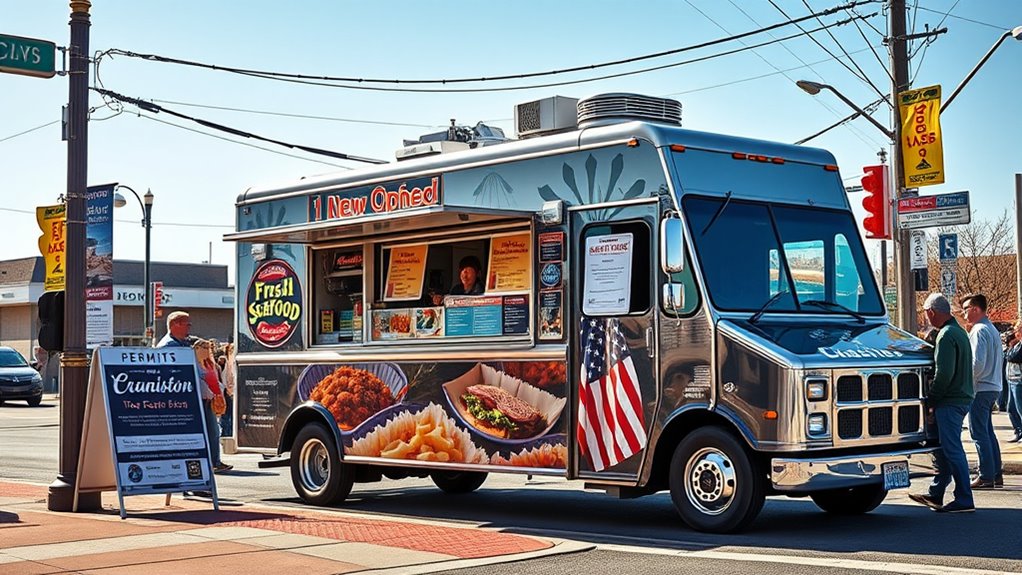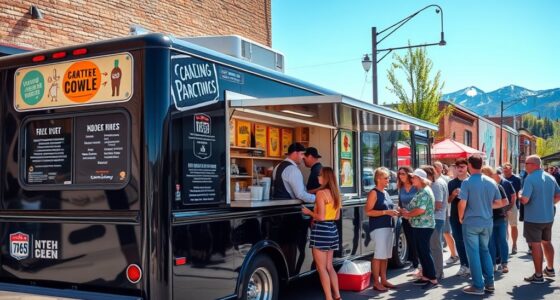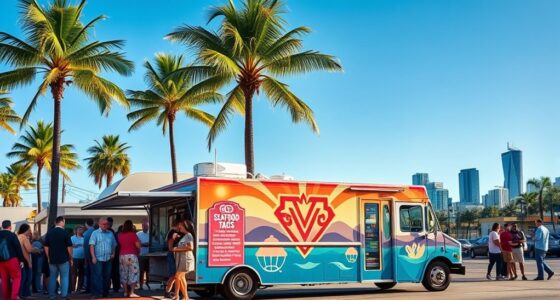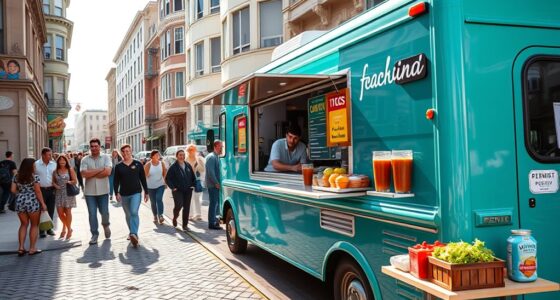To open a food truck in Cranston, Rhode Island, you’ll need to secure permits from the Rhode Island Department of Health and Cranston city, including a Mobile Food Establishment registration (~$50) and an annual license (~$100). Find legal locations by maintaining distance from restaurants and entertainment venues, and get property owner permissions. Develop compliant menus focused on safety and allergen labeling. For marketing, use social media and local events. Exploring these steps further can help you start smoothly.
Key Takeaways
- Obtain necessary state and municipal permits, including a Mobile Food Establishment registration (~$50) and Cranston-specific annual license (~$100).
- Ensure compliance with location restrictions, maintaining at least 200 feet from restaurants and 300 feet from entertainment venues.
- Develop a compliant menu avoiding prohibited items, with proper sourcing, labeling, and safety standards for ingredients and equipment.
- Conduct fire safety inspections, secure necessary certifications, and budget for insurance, signage, and waste disposal costs.
- Promote your food truck via social media, participate in local events, and implement loyalty programs to increase customer engagement.
Understanding State and Local Permitting Requirements
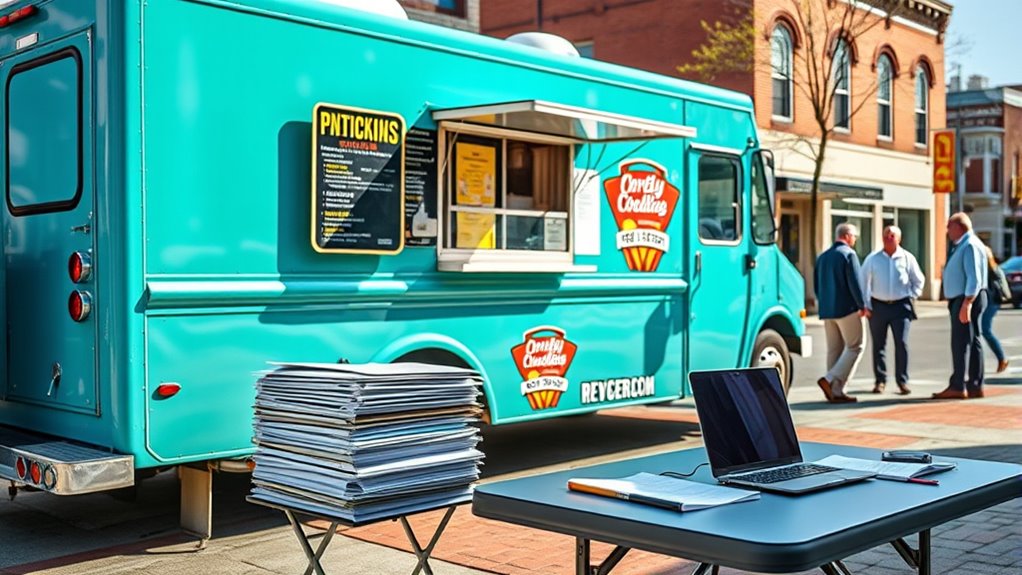
Understanding the permitting requirements for operating a food truck in Cranston, Rhode Island, is essential to guarantee you’re fully compliant with both state and local regulations. First, you must register your Mobile Food Establishment (MFE) with the Rhode Island Department of Health, which is mandatory for all food trucks statewide. You’ll also need a Mobile Food Service License from RIDOH before starting operations. Fire safety is vital; the State Fire Marshal conducts inspections within 14 business days, and trucks using propane require gas alarm installation and monthly testing. On the local level, Cranston requires a separate MFE permit for each truck, typically renewed annually, and permits must align with state regulations. Keep in mind that municipal permits do not replace state licenses, so both are necessary for legal operation. Additionally, having a comprehensive understanding of licensing procedures ensures a smoother approval process. To facilitate compliance, it’s advisable to consult local health departments early in planning to address any specific municipal requirements.
Navigating Costs and Fees for Licensing and Compliance
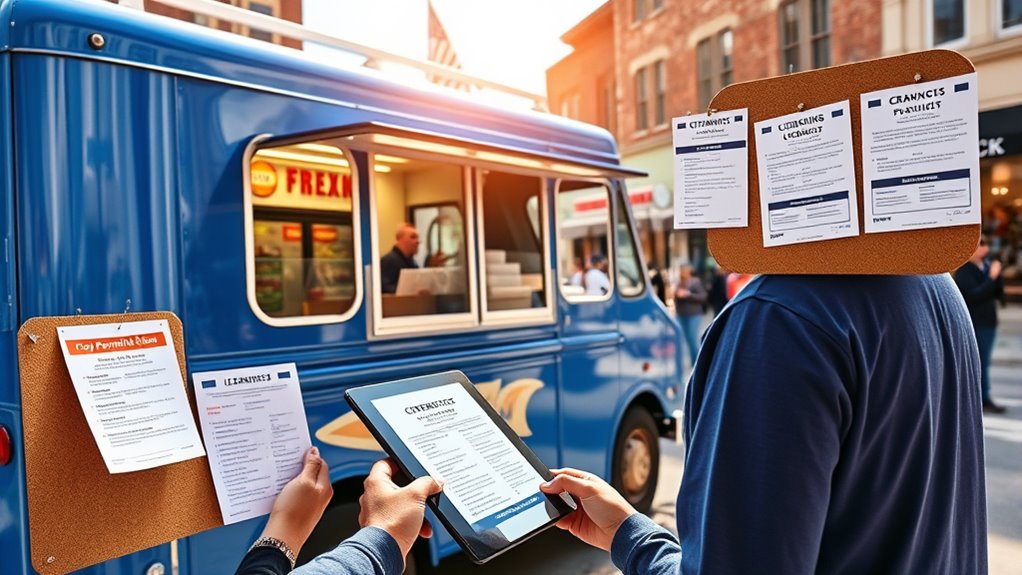
Managing the costs and fees associated with licensing and compliance is a crucial step in launching your food truck in Cranston, Rhode Island. You’ll need to budget for several fees: a $50 Mobile Food Establishment registration, roughly $100 annually for the Mobile Food Service License, and between $50 and $100 for fire inspection certificates if you use propane or generators. A Retail Sales Permit costs $10, and a business license for your entity is about $150. Fire safety costs include installing UL-rated gas alarms and regular testing. Expect a municipal permit fee of around $75 for Cranston, with renewal requirements. Additionally, you’ll need liability and vehicle insurance, plus potential expenses for signage, waste disposal, and parking. Carefully plan these costs to ensure compliance without surprises. Obtaining an Employer Identification Number (EIN) from the IRS is also recommended for tax purposes and opening business accounts. Proper budgeting for licensing fees and ongoing compliance costs helps prevent unexpected expenses down the line.
Locating Your Food Truck in Cranston: Permitted Areas and Regulations
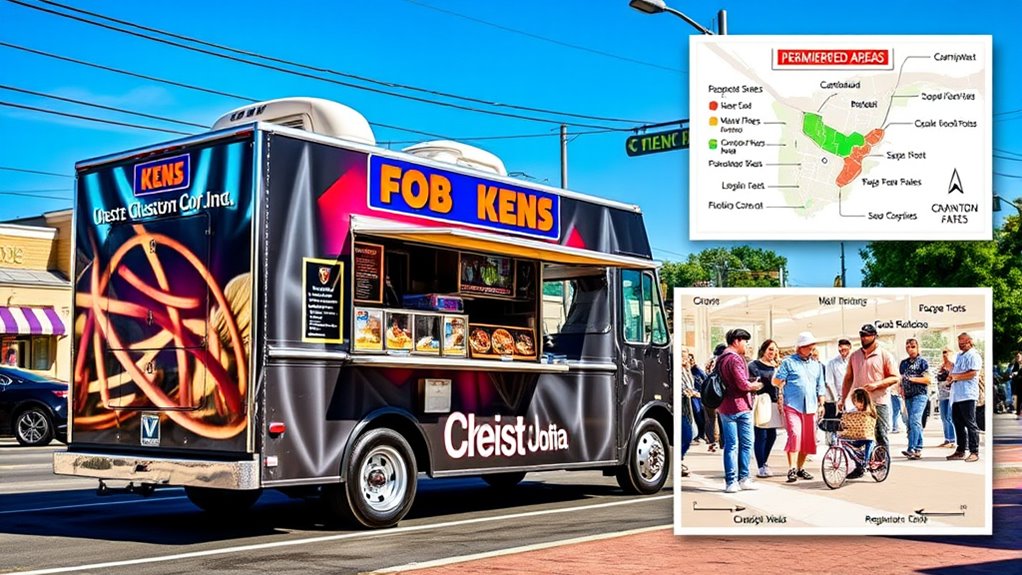
Finding the right location for your food truck in Cranston involves maneuvering specific rules and restrictions designed to balance business opportunities with community safety. You can operate on public rights-of-way but must respect distance restrictions, such as staying at least 200 feet from restaurant or institutional entrances during their open hours unless you get written permission. You also need to keep at least 300 feet away from entertainment venues to avoid conflicts. Securing written permission from property owners within 50 feet of your vending spot is often necessary. Local ordinances may add additional restrictions, so check with the Cranston city council or local authorities. Enforcement involves coordination with city officials, ensuring your location complies with safety, noise, and environmental regulations. Additionally, obtaining a special permit or license may be required for certain zones or during specific events to ensure legal operation. Incorporating knowledge about zoning regulations and compliance can help you navigate local restrictions more effectively.
Crafting a Menu That Meets Regulatory Standards
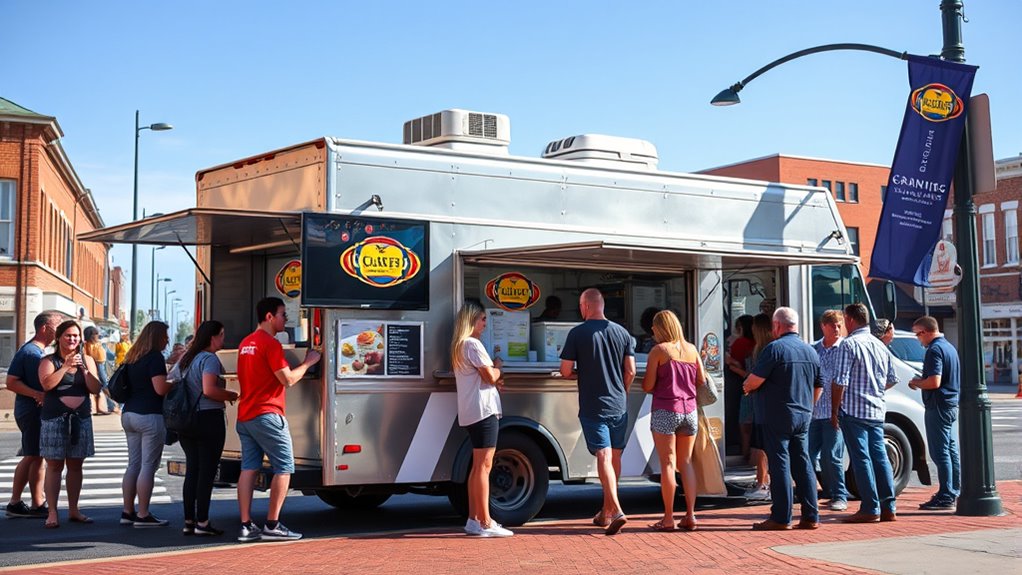
Crafting a menu that meets regulatory standards requires careful planning to guarantee all offerings comply with Rhode Island Department of Health requirements. You must select foods that adhere to regulations for mobile food establishments, avoiding prohibited items like alcohol, which aren’t permitted under MFE licenses. All menu items must meet strict sanitation, temperature, and ingredient safety standards, with proper labeling for allergens and approved sourcing. Your menu should consider limited space and equipment, ensuring dishes can be prepared safely within your truck’s constraints. Using propane or electrical equipment requires fire safety protocols and UL-listed alarms, so choose menu items compatible with these systems. Finally, document ingredient sourcing and storage practices to maintain compliance during inspections and ongoing operations.
Effective Marketing Strategies to Grow Your Food Truck Business
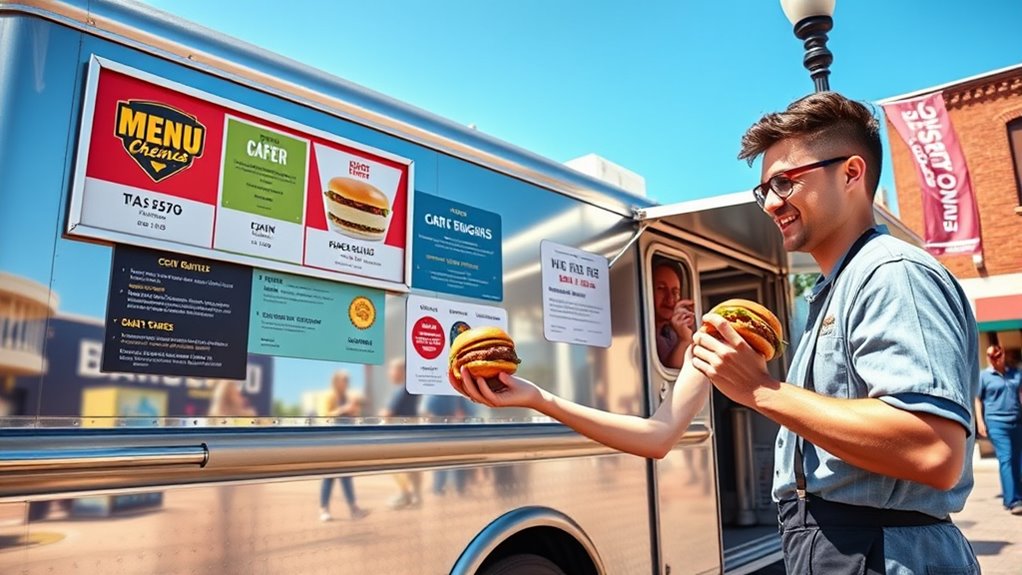
Building a strong marketing strategy is key to expanding your food truck’s reach and boosting sales. Social media is a powerful tool; 68% of food truck owners use it regularly, with 75% active on Facebook. Engaging campaigns can increase sales by 20% and encourage customers to spend 15% more. Participating in local events and festivals also boosts visibility, with 80% of trucks attending at least three annually. These gatherings attract community customers and generate word-of-mouth marketing. Loyalty and email programs foster repeat business, with over half of trucks implementing such systems, leading to a 30% increase in visits. Additionally, using mobile apps and GPS tech enhances customer convenience, while data analytics help tailor marketing efforts, ensuring higher ROI and more effective advertising campaigns. Market growth and industry expansion By leveraging these digital tools and community engagement strategies, your food truck can establish a strong presence and sustain long-term success in a competitive market. Incorporating customer feedback can further refine your marketing tactics and improve overall service quality.
Ensuring Compliance and Maintaining Operational Standards
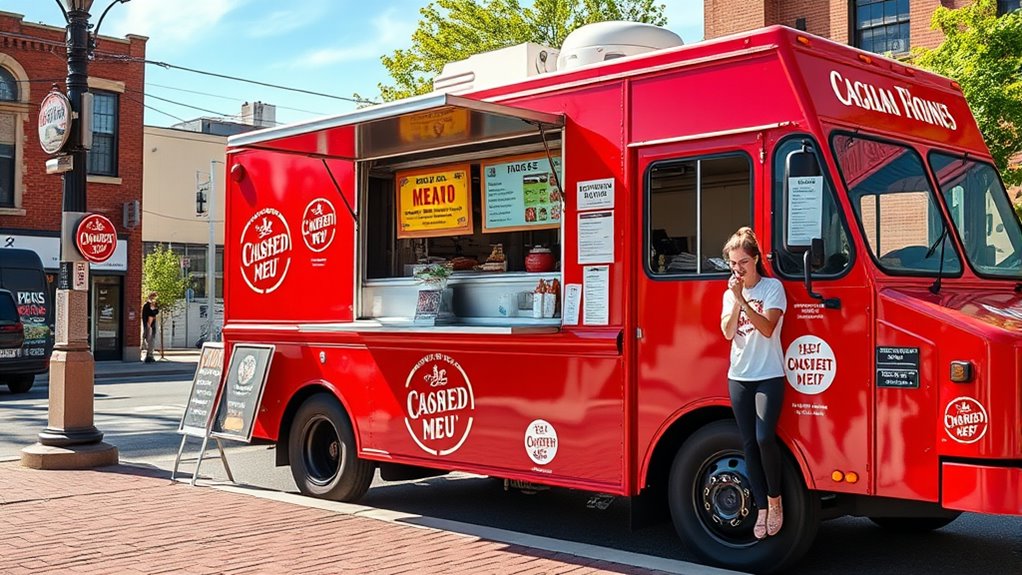
Ensuring compliance and maintaining operational standards are essential for your food truck’s legality, safety, and reputation. You must register your truck with the Rhode Island Department of Business Regulation and obtain a Mobile Food Service license from the Department of Health, passing inspections and following the Rhode Island Food Code. At least one certified food safety manager with ServSafe certification must be present during operations. Your truck needs proper refrigeration, a three-compartment sink, and a handwashing station. Propane systems require UL 1484 alarms and regular testing logged for safety. Inspections by the State Fire Marshal and Cranston Fire Department ensure fire and health standards are met. State-mandated training and documentation are crucial for ongoing compliance. Proper storage of ingredients and supplies in airtight containers helps preserve freshness and prevent contamination. Failing to comply can lead to permit suspension or revocation, so staying current on regulations is critical.
Frequently Asked Questions
How Long Does the Entire Permitting Process Typically Take in Cranston?
The entire permitting process in Cranston usually takes between 1 to 3 months. You’ll need to start with your state registration, which can take a few weeks, and then submit your municipal permit application. Keep in mind that fire safety inspections and compliance checks might add extra days or weeks. Planning ahead and ensuring all documentation is complete can help speed up the process and avoid delays.
Are There Any Restrictions on Operating Hours for Food Trucks in Cranston?
You need to be aware that Cranston regulates food truck operating hours through city permits. You must submit a detailed schedule for approval, and your hours can’t conflict with restrictions like proximity rules or noise ordinances. Operating times require prior approval from city departments, and you must conform to safety codes and location restrictions. Staying informed about periodic updates to local regulations helps ensure your hours remain compliant and your permit stays valid.
Can I Operate My Food Truck at Private Events Without Additional Permits?
While it might seem straightforward, operating your food truck at private events in Rhode Island still calls for some paperwork. You’ll need to get approval from the event venue and verify your insurance and licenses are in order. Securing these documents ahead of time, typically 30 days or more, helps you smoothly serve your customers without any hiccups. Always check with the venue to confirm their specific requirements for a hassle-free experience.
What Are the Penalties for Non-Compliance With Food Truck Regulations?
You’re wondering what happens if you don’t follow food truck rules in Cranston. If you violate regulations, you face fines up to $300 daily per violation, with each day counting separately. Your permit can be revoked or suspended after a hearing, and your vehicle could be impounded. Enforcement agencies can issue tickets, enforce penalties, and even remove your truck from operation, risking your ability to run your business legally.
Is There a Limit on the Number of Food Trucks Allowed in Cranston?
You wonder if Cranston limits food trucks—imagine a city so restricted, it’s like trying to fit a thousand trucks in a tiny box! While there’s no strict numerical cap, the 1,000-foot spacing rule and permit requirements act like giant walls, keeping trucks scattered and limited. So, although no fixed limit exists, these regulations practically control how many trucks can operate and where, making the arena feel quite small.
Conclusion
Starting a food truck in Cranston might seem overwhelming, but with the right permits, location choices, and marketing, you can turn your passion into a thriving business. Stay compliant, craft a tempting menu, and promote yourself effectively. Are you ready to hit the streets and serve up your unique flavors? With careful planning and dedication, your food truck dreams can become a delicious reality. Why wait—your culinary adventure awaits!
